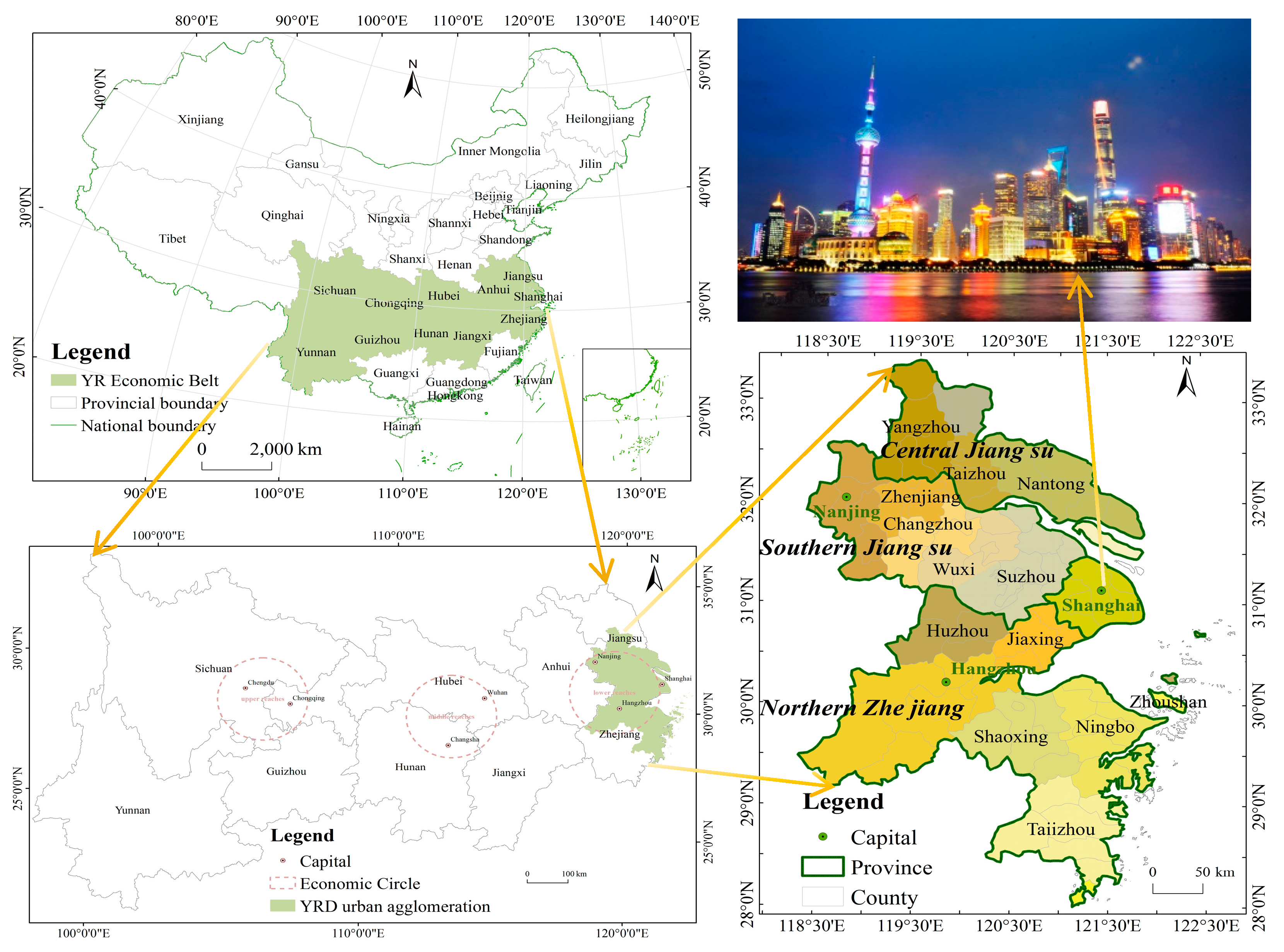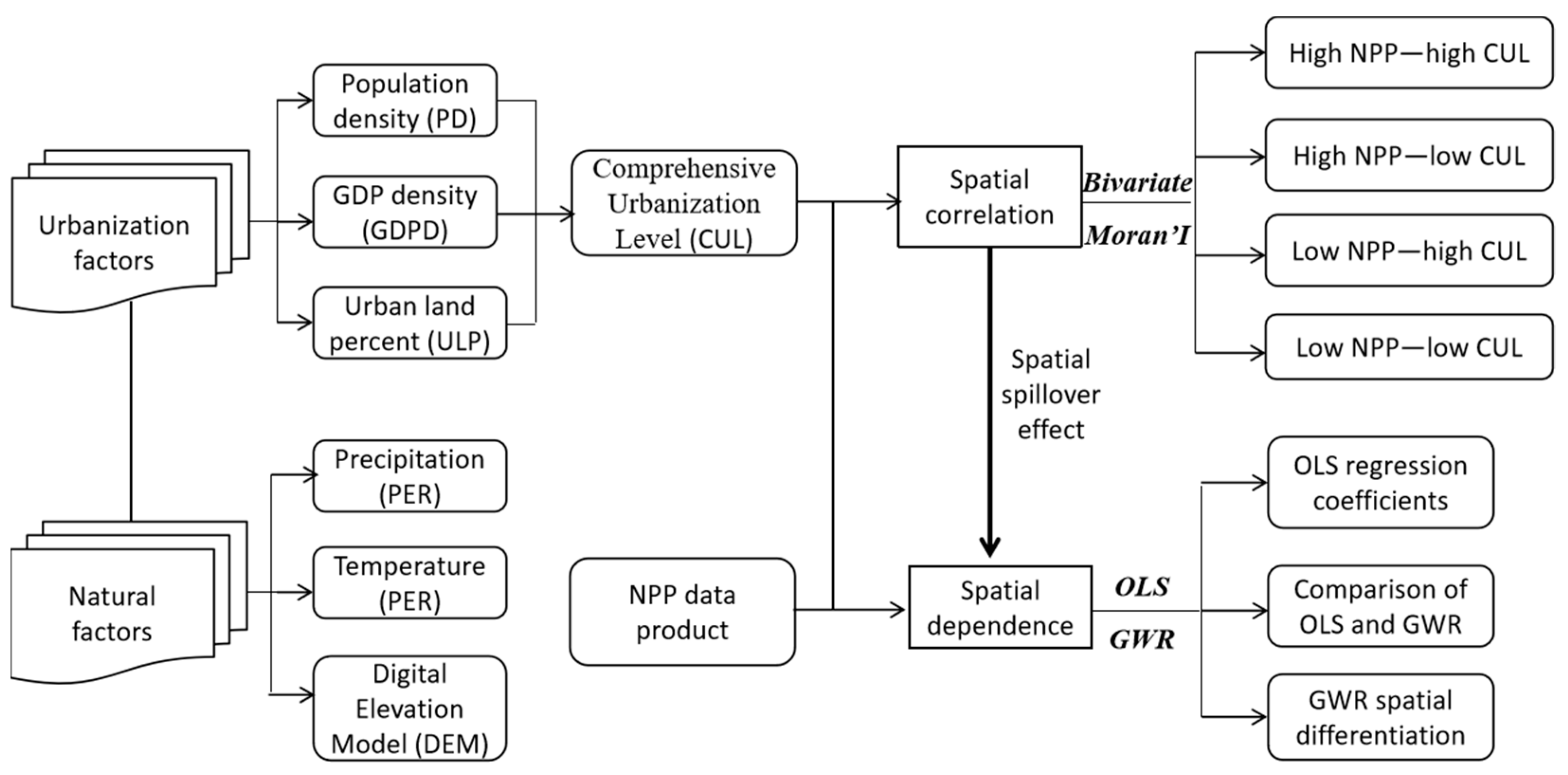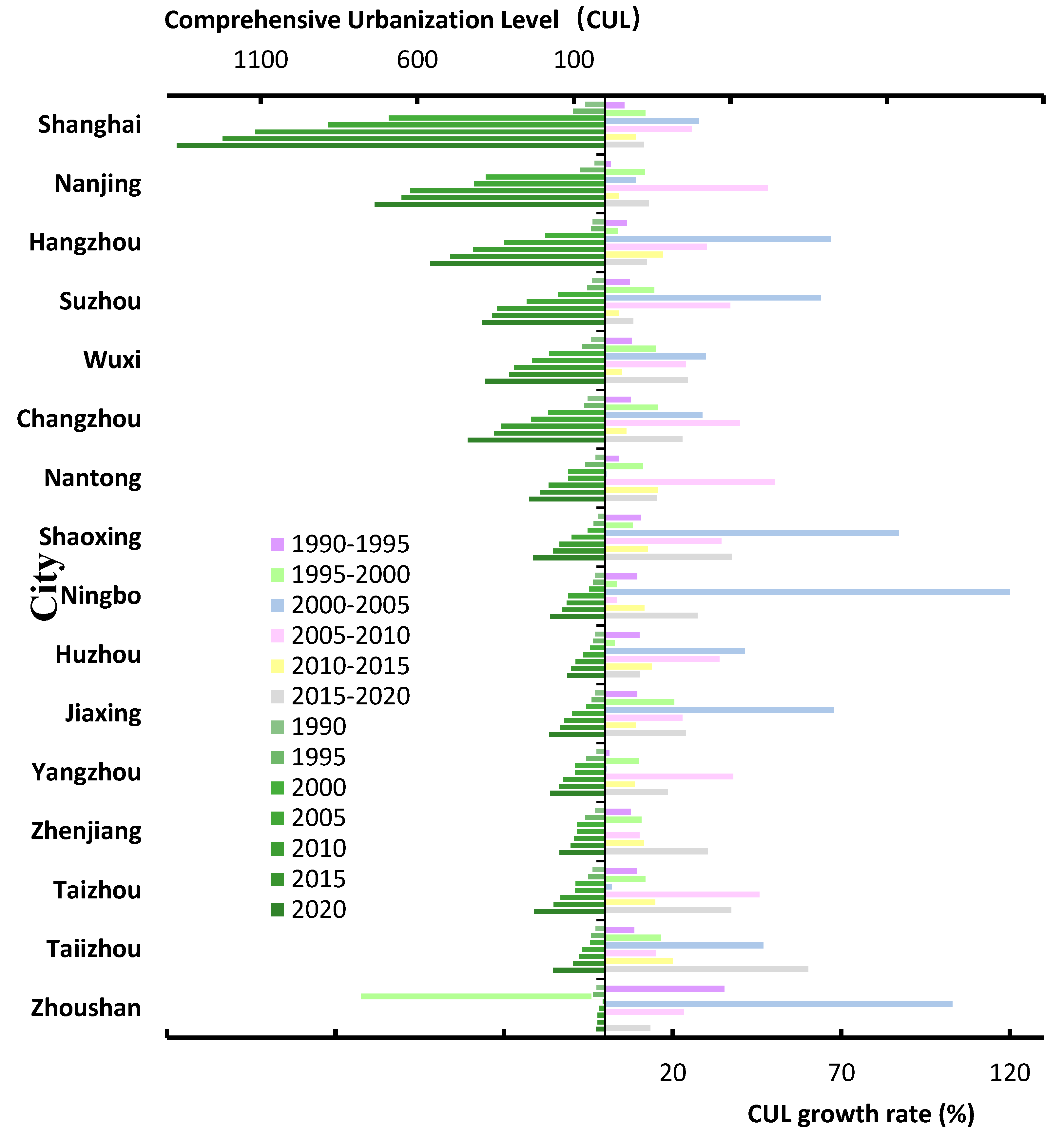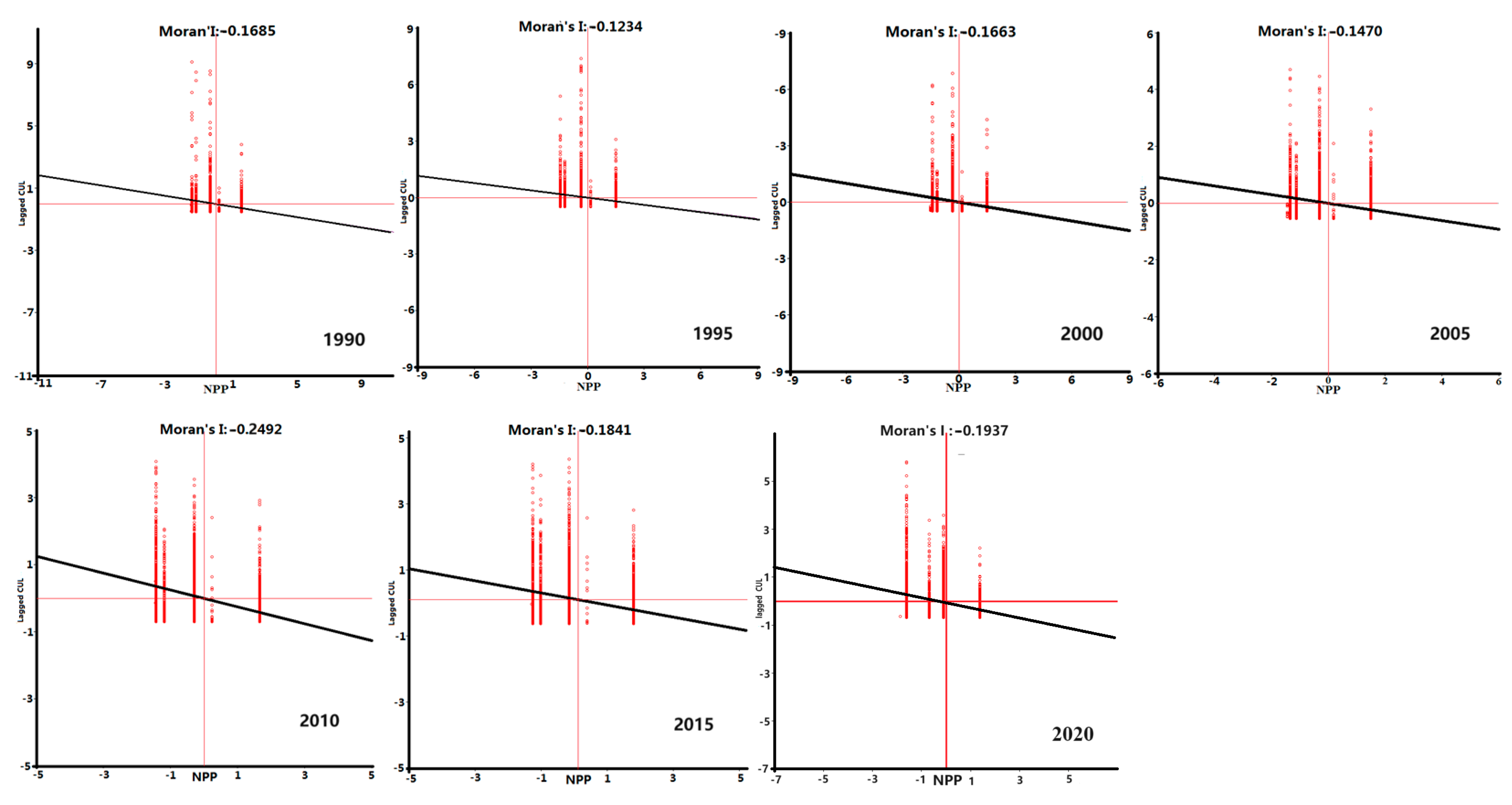Unveiling the Impact of Urbanization on Net Primary Productivity: Insights from the Yangtze River Delta Urban Agglomeration
Abstract
:1. Introduction
2. Materials and Methods
2.1. Study Area
2.2. Data Sources
2.3. Data Analyses and Methods
2.3.1. Urbanization Assessment
2.3.2. Spatial Correlation Measure
2.3.3. Spatial Regression Test
- Analysis of global spatial regression
- 2.
- Analysis of local spatial regression
3. Results
3.1. Spatial CUL Patterns in the YRDUA
3.2. Geographical Links between Urbanization and NPP
3.3. Spatial NPP Pattern Dependence on Urbanization
4. Discussion
4.1. Geographical Spillover Consequences in the Correlation between Urbanization and NPP
- Examining the correlation between NPP and urbanization, it was evident that from 1990 to 2020, the geographical arrangement of regions deemed as not significant remained consistent. These areas are mostly located on the outskirts of metropolitan agglomerations. This is due to the fact that, compared to the Shanghai, Suzhou–Wuxi–Changzhou, and Nanjing metropolitan areas, these places exhibited a lower level of urbanization activities, such as population concentration, economic investment, and land development. Hence, urbanization is not the primary influence on NPP on the outskirts of metropolitan agglomerations;
- In 2010, the geographical correlations of NPP and urbanization were highest in the high–high and low–high areas. The regions at the highest elevations are mostly located in the inner region, while the regions at lower elevations are found around the urban built-up areas. Prior to 2010, the rate of urban expansion exhibited a consistent and steady increase. Since 2010, there has been a growing awareness at both the national and regional levels of the rapid expansion of urban agglomerations and the environmental pollution issues associated with economic development and high-energy-consuming industries. These factors have significantly contributed to global climate change and the degradation of the ecological environment. Consequently, regulations have been implemented to regulate the unrestricted expansion of urban areas and reconfigure energy-intensive businesses in order to transition and enhance the use of clean energy sources. Hence, starting in 2015, the association between NPP and urbanization seemed to diminish;
- The geographical distribution patterns of NPP and urbanization in 2000 and 2010 exhibited a significant degree of similarity. This outcome aligns with the findings of Qiu’s study. He discovered that the decade spanning from 2000 to 2010 had the highest rate of urbanization and the greatest stability for the urban agglomeration of the Yangtze River Delta. During this time, the urban agglomeration underwent a phase of creation and development, with a consistent and continuous increase in the level of urbanization [56]. Simultaneously, the decline in NPP failed to attract attention and recognition for its effect and repercussions. The decline in NPP and the rise in anthropogenic carbon emissions are not being effectively managed and regulated. NPP and urbanization exhibited a strong geographical correlation, indicating a consistent pattern of spatial clustering.
4.2. NPP and CUL Spatial Link Implications for Urban Agglomeration Development Programs
4.3. Limitations of the Applied Method
5. Conclusions
Supplementary Materials
Author Contributions
Funding
Data Availability Statement
Acknowledgments
Conflicts of Interest
References
- Qiu, B.K.; Li, H.L.; Zhou, M.; Zhang, L. Vulnerability of ecosystem services provisioning to urbanization: A case of China. Ecol. Indic. 2015, 57, 505–513. [Google Scholar] [CrossRef]
- Seto, K.C.; Guneralp, B.; Hutyra, L.R. Global forecasts of urban expansion to 2030 and direct impacts on biodiversity and carbon pools. Proc. Natl. Acad. Sci. USA 2012, 109, 16083–16088. [Google Scholar] [CrossRef]
- Yan, Y.C.; Liu, X.P.; Wang, F.Y.; Li, X.; Ou, J.P.; Wen, Y.Y.; Liang, X. Assessing the impacts of urban sprawl on net primary productivity using fusion of Landsat and MODIS data. Sci. Total Environ. 2018, 613, 1417–1429. [Google Scholar] [CrossRef]
- Li, J.; Bi, M.; Wei, G. Investigating the Impacts of Urbanization on Vegetation Net Primary Productivity: A Case Study of Chengdu–Chongqing Urban Agglomeration from the Perspective of Townships. Land 2022, 11, 2077. [Google Scholar] [CrossRef]
- Guan, X.; Shen, H.; Li, X.; Gan, W.; Zhang, L. A long-term and comprehensive assessment of the urbanization-induced impacts on vegetation net primary productivity. Sci. Total Environ. 2019, 669, 342–352. [Google Scholar] [CrossRef]
- Li, H.; Zhang, H.; Li, Q.; Zhao, J.; Guo, X.; Ying, H.; Deng, G.; Rihan, W.; Wang, S. Vegetation Productivity Dynamics in Response to Climate Change and Human Activities under Different Topography and Land Cover in Northeast China. Remote Sens. 2021, 13, 975. [Google Scholar] [CrossRef]
- Qin, K.; Li, J.; Liu, J.; Yan, L.; Huang, H. Setting conservation priorities based on ecosystem services—A case study of the Guanzhong-Tianshui Economic Region. Sci. Total Environ. 2018, 650, 3062–3074. [Google Scholar] [CrossRef]
- Wang, H.; Liu, G.; Li, Z.; Zhang, L.; Wang, Z. Processes and driving forces for changing vegetation ecosystem services: Insights from the Shaanxi Province of China. Ecol. Indic. 2020, 112, 106105. [Google Scholar] [CrossRef]
- Wu, S.H.; Zhou, S.L.; Chen, D.X.; Wei, Z.Q.; Dai, L.; Li, X.G. Determining the contributions of urbanisation and climate change to NPP variations over the last decade in the Yangtze River Delta, China. Sci. Total Environ. 2014, 472, 397–406. [Google Scholar] [CrossRef]
- Pei, F.S.; Li, X.; Liu, X.P.; Lao, C.H.; Xia, G.R. Exploring the response of net primary productivity variations to urban expansion and climate change: A scenario analysis for Guangdong Province in China. J. Environ. Manag. 2015, 150, 92–102. [Google Scholar] [CrossRef] [PubMed]
- Yao, R.; Zhang, S.; Sun, P.; Bian, Y.; Yang, Q.; Guan, Z.; Zhang, Y. Diurnal Variations in Different Precipitation Duration Events over the Yangtze River Delta Urban Agglomeration. Remote Sens. 2022, 14, 5244. [Google Scholar] [CrossRef]
- Paolini, L.; Araoz, E.; Gioia, A.; Powell, P.A. Vegetation productivity trends in response to urban dynamics. Urban For. Urban Green. 2016, 17, 211–216. [Google Scholar] [CrossRef]
- Costanza, R.; d'Arge, R.; de Groot, R.; Farber, S.; Grasso, M.; Hannon, B.; Limburg, K.; Naeem, S.; O'Neill, R.V.; Paruelo, J.; et al. The value of the world’s ecosystem services and natural capital. Nature 1997, 387, 253–260. [Google Scholar] [CrossRef]
- Keeler, B.L.; Polasky, S.; Brauman, K.A.; Johnson, K.A.; Finlay, J.C.; O'Neill, A.; Kovacs, K.; Dalzell, B. Linking water quality and well-being for improved assessment and valuation of ecosystem services. Proc. Natl. Acad. Sci. USA 2012, 109, 18619–18624. [Google Scholar] [CrossRef]
- Cramer, W.; Kicklighter, D.W.; Bondeau, A.; Moore, B.; Churkina, G.; Nemry, B.; Ruimy, A.; Schloss, A.L. Comparing global models of terrestrial net primary productivity (NPP): Overview and key results. Glob. Change Biol. 1999, 5, 1–15. [Google Scholar] [CrossRef]
- Piao, S.L.; Fang, J.Y.; Chen, A.P. Seasonal dynamics of terrestrial net primary production in response to climate changes in China. Acta Bot. Sin. 2003, 45, 269–275. [Google Scholar]
- Duan, H.; Xue, X.; Wang, T.; Kang, W.; Liao, J.; Liu, S. Spatial and Temporal Differences in Alpine Meadow, Alpine Steppe and All Vegetation of the Qinghai-Tibetan Plateau and Their Responses to Climate Change. Remote Sens. 2021, 13, 669. [Google Scholar] [CrossRef]
- Betts, R.A.; Boucher, O.; Collins, M.; Cox, P.M.; Falloon, P.D.; Gedney, N.; Hemming, D.L.; Huntingford, C.; Jones, C.D.; Sexton, D.M.H.; et al. Projected increase in continental runoff due to plant responses to increasing carbon dioxide. Nature 2007, 448, 1037–1041. [Google Scholar] [CrossRef]
- Grimm, N.B.; Grove, J.M.; Pickett, S.T.A.; Redman, C.L. Integrated approaches to long-term studies of urban ecological systems. Bioscience 2000, 50, 571–584. [Google Scholar] [CrossRef]
- Imhoff, M.L.; Bounoua, L.; DeFries, R.; Lawrence, W.T.; Stutzer, D.; Tucker, C.J.; Ricketts, T. The consequences of urban land transformation on net primary productivity in the United States. Remote Sens. Environ. 2004, 89, 434–443. [Google Scholar] [CrossRef]
- McRoberts, R.E. Probability- and model-based approaches to inference for proportion forest using satellite imagery as ancillary data. Remote Sens. Environ. 2010, 114, 1017–1025. [Google Scholar] [CrossRef]
- Tian, G.J.; Qiao, Z. Assessing the impact of the urbanization process on net primary productivity in China in 1989–2000. Environ. Pollut. 2014, 184, 320–326. [Google Scholar] [CrossRef]
- Paz-Kagan, T.; Shachak, M.; Zaady, E.; Karnieli, A. Evaluation of ecosystem responses to land-use change using soil quality and primary productivity in a semi-arid area, Israel. Agric. Ecosyst. Environ. 2014, 193, 9–24. [Google Scholar] [CrossRef]
- Qi, S.; Chen, S.; Long, X.; An, X.; Zhang, M. Quantitative contribution of climate change and anthropological activities to vegetation carbon storage in the Dongting Lake basin in the last two decades. Adv. Space Res. 2023, 71, 845–868. [Google Scholar] [CrossRef]
- Shi, S.; Yu, J.; Wang, F.; Wang, P.; Zhang, Y.; Jin, K. Quantitative contributions of climate change and human activities to vegetation changes over multiple time scales on the Loess Plateau. Sci. Total Environ. 2021, 755, 142419. [Google Scholar] [CrossRef]
- Zhang, M.; Yuan, N.; Lin, H.; Liu, Y.; Zhang, H. Quantitative estimation of the factors impacting spatiotemporal variation in NPP in the Dongting Lake wetlands using Landsat time series data for the last two decades. Ecol. Indic. 2022, 135, 108544. [Google Scholar] [CrossRef]
- Field, C.B.; Behrenfeld, M.J.; Randerson, J.T.; Falkowski, P. Primary production of the biosphere: Integrating terrestrial and oceanic components. Science 1998, 281, 237–240. [Google Scholar] [CrossRef]
- Zhao, S.Q.; Liu, S.G.; Zhou, D.C. Prevalent vegetation growth enhancement in urban environment. Proc. Natl. Acad. Sci. USA 2016, 113, 6313–6318. [Google Scholar] [CrossRef]
- Peng, J.; Shen, H.; Wu, W.H.; Liu, Y.X.; Wang, Y.L. Net primary productivity (NPP) dynamics and associated urbanization driving forces in metropolitan areas: A case study in Beijing City, China. Landsc. Ecol. 2016, 31, 1077–1092. [Google Scholar] [CrossRef]
- Su, S.L.; Li, D.L.; Hu, Y.N.; Xiao, R.; Zhang, Y. Spatially non-stationary response of ecosystem service value changes to urbanization in Shanghai, China. Ecol. Indic. 2014, 45, 332–339. [Google Scholar] [CrossRef]
- Fang, J.Y.; Chen, A.P.; Peng, C.H.; Zhao, S.Q.; Ci, L. Changes in forest biomass carbon storage in China between 1949 and 1998. Science 2001, 292, 2320–2322. [Google Scholar] [CrossRef]
- Guerschman, J.P.; Mcvicar, T.R.; Vleeshower, J.; Niel, T.G.V.; Pea-Arancibia, J.L.; Chen, Y. Estimating actual evapotranspiration at field-to-continent scales by calibrating the CMRSET algorithm with MODIS, VIIRS, Landsat and Sentinel-2 data. J. Hydrol. 2022, 605, 127318. [Google Scholar] [CrossRef]
- Liu, J.; Liu, M.; Tian, H.; Zhuang, D.; Zhang, Z.; Zhang, W.; Tang, X.; Deng, X. Spatial and temporal patterns of China’s cropland during 1990–2000: An analysis based on Landsat TM data. Remote Sens. Environ. 2005, 98, 442–456. [Google Scholar] [CrossRef]
- Liu, J.; Zhang, Z.; Xu, X.; Kuang, W.; Zhou, W.; Zhang, S.; Li, R.; Yan, C.; Yu, D.; Wu, S. Spatial patterns and driving forces of land use change in China during the early 21st century. J. Geogr. Sci. 2010, 20, 483–494. [Google Scholar] [CrossRef]
- Liu, H.; Jiang, D.; Yang, X.; Luo, C. Spatialization Approach to 1km Grid GDP Supported by Remote Sensing. Geo-Inf. Sci. 2005, 7, 120–123. [Google Scholar]
- Wei, S.; Dong, Y.; Qiu, Y.; Li, B.; Li, S.; Dong, C. Temporal and spatial analysis of vegetation cover change in the Yellow River Delta based on Landsat and MODIS time series data. Environ. Monit. Assess. 2023, 195, 1057. [Google Scholar] [CrossRef]
- Wolock, D.M.; Mccabe, G.J. Differences in topographic characteristics computed from 100- and 1000-m resolution digital elevation model data. Hydrol. Process. 2015, 14, 987–1002. [Google Scholar] [CrossRef]
- Jianxin, Z.; Lufeng, D. Measure on the Development Relationship of China’s Urbanization and Industrialization. Ecol. Econ. 2009, 2011, 15–21. [Google Scholar]
- Roser, L. Moran’s I, Geary’s C and Bivariate Moran’s I Correlograms. Available online: https://leandroroser.github.io/EcoGenetics-documentation/reference/eco.correlog.html (accessed on 12 June 2021).
- Aguiar, M.A.M.D.; Baranger, M.; Baptestini, E.M.; Kaufman, L.; Bar-Yam, Y. Global patterns of speciation and diversity. Nature 2009, 460, 384–387. [Google Scholar] [CrossRef]
- Arruda, R.M.F.D.; Cardoso, D.T.; Teixeira-Neto, R.G.; Barbosa, D.S.; Ferraz, R.K.; Morais, M.H.F.; Belo, V.S.; Silva, E.S.d. Space-time analysis of the incidence of human visceral leishmaniasis (VL) and prevalence of canine VL in a municipality of southeastern Brazil: Identification of priority areas for surveillance and control. Acta Trop. J. Biomed. Sci. 2019, 197, 105052. [Google Scholar] [CrossRef]
- Avise, M.J.C. Comparative phylogenetic analysis of male alternative reproductive tactics in ray-finned fishes. Evolution 2006, 60, 1311–1316. [Google Scholar]
- Jayakumar, K.; Mundassery, D.A. On Moran’s Bivariate Gamma and Bivariate Negative Binomial Distribution. Calcutta Stat. Assoc. Bull. 2007, 59, 15–27. [Google Scholar] [CrossRef]
- Matkan, A.A.; Mohaymany, A.S.; Shahri, M.; Mirbagheri, B. Detecting the spatial–temporal autocorrelation among crash frequencies in urban areas. Can. J. Civ. Eng. 2013, 40, 195–203. [Google Scholar] [CrossRef]
- Lee, S.I. Developing a bivariate spatial association measure: An integration of Pearson’s r and Moran’s I. J. Geogr. Syst. 2001, 3, 369–385. [Google Scholar] [CrossRef]
- Shuang, L.; Yan-Hua, Z. The Spatial Distribution and the Convergence of Human Capital in Cities of China. Sci. Technol. Econ. 2019, 32, 71–75. [Google Scholar]
- Anselin, L. Local Indicators of Spatial Association—LISA. Geogr. Anal. 1995, 27, 93–115. [Google Scholar] [CrossRef]
- Shen, W.; Huang, Z.; Yin, S.; Hsu, W.-L. Temporal and Spatial Coupling Characteristics of Tourism and Urbanization with Mechanism of High-Quality Development in the Yangtze River Delta Urban Agglomeration, China. Appl. Sci. 2022, 12, 3403. [Google Scholar] [CrossRef]
- Changfeng, L.; Xiaotian, L. Research on the development of high-tech industry and technology service industry based on industrial collaborative evolution: Case of Jiangsu province. Jiangsu Sci. Technol. Inf. 2018, 35, 1–5. [Google Scholar]
- Souris, M.; Bichaud, L. Statistical methods for bivariate spatial analysis in marked points. Ex. Spat. Epidemiol. Spat. Spatio-Temporal Epidemiol. 2011, 2, 227–234. [Google Scholar] [CrossRef]
- Zhao, H.; Duan, X.; Stewart, B.; You, B.; Jiang, X. Spatial correlations between urbanization and river water pollution in the heavily polluted area of Taihu Lake Basin, China. J. Geogr. Sci. 2013, 23, 735–752. [Google Scholar] [CrossRef]
- Bellamy, S.A.H.E. The influence of hedge structure, management and landscape context on the value of hedgerows to birds: A review. J. Environ. Manag. 2000, 60, 33–49. [Google Scholar]
- Lewis, J.A.; Zipperer, W.C.; Ernstson, H.; Bernik, B.; Hazen, R.; Elmqvist, T.; Blum, M.J. Socioecological disparities in New Orleans following Hurricane Katrina. Ecosphere 2017, 8, e01922. [Google Scholar] [CrossRef]
- Costa, M.; Iezzi, S. Technology spillover and regional convergence process: A statistical analysis of the Italian case. Stat. Methods Appl. 2004, 13, 375–398. [Google Scholar] [CrossRef]
- Zhang, Z.M.; Gao, J.F.; Fan, X.Y.; Lan, Y.; Zhao, M.S. Response of ecosystem services to socioeconomic development in the Yangtze River Basin, China. Ecol. Indic. 2017, 72, 481–493. [Google Scholar] [CrossRef]
- Qiu, L.; Lindberg, S.; Nielsen, A.B. Is biodiversity attractive?—On-site perception of recreational and biodiversity values in urban green space. Landsc. Urban Plan. 2013, 119, 136–146. [Google Scholar] [CrossRef]
- Yuan, J.; Lu, Y.; Ferrier, R.C.; Liu, Z.; Su, H.; Meng, J.; Song, S.; Jenkins, A. Urbanization, rural development and environmental health in China. Environ. Dev. 2018, 28, 101–110. [Google Scholar] [CrossRef]
- Niu, Q.; Yu, L.; Jie, Q.; Li, X. An urban eco-environmental sensitive areas assessment method based on variable weights combination. Environ. Dev. Sustain. 2020, 22, 2069–2085. [Google Scholar] [CrossRef]
- Guan, X.; Wei, H.; Lu, S.; Dai, Q.; Su, H. Assessment on the urbanization strategy in China: Achievements, challenges and reflections. Habitat Int. 2018, 71, 97–109. [Google Scholar] [CrossRef]
- NDRC. Yangtze River Delta Urban Agglomeration Development Plan. National Development and Reform Commission. 2016. Available online: http://www.ndrc.gov.cn/zcfb/zcfbghwb/201606/t20160603_806390.html (accessed on 16 June 2018).
- Ting, M.; Zhan, Y.; Alicia, Z. Delineating Spatial Patterns in Human Settlements Using VIIRS Nighttime Light Data: A Watershed-Based Partition Approach. Remote Sens. 2018, 10, 465. [Google Scholar] [CrossRef]
- Ye, C.; Zhu, J.; Li, S.; Yang, S. Assessment and analysis of regional economic collaborative development within an urban agglomeration: Yangtze River Delta as a case study. Habitat Int. 2019, 83, 20–29. [Google Scholar] [CrossRef]
- Jing, W.; Hong-Lian, W.; Chong, Z. Temporal and Spatial Changes and Influencing Factors of Vegetation Cover in Baoji Area Based on MODIS Data. Acta Agric. Jiangxi 2018, 30, 127–133. [Google Scholar]







| Year | Variable | Coefficient | Standard Deviation | t/z Value | p-Value (>|t|) |
|---|---|---|---|---|---|
| 1990 | (Intercept) | 0.23 | 0.03 | 19.79 | 0.00 ** |
| PD | 0.02 | 0.17 | 0.09 | 0.93 * | |
| GDPD | −0.55 | 0.14 | −3.93 | 0.00 | |
| ULP | 0.35 | 0.12 | 2.83 | 0.01 ** | |
| CUL | −0.48 | 0.34 | −3.16 | 0.01 *** | |
| TEM | −0.37 | 0.04 | −10.23 | 0.00 ** | |
| PRE | 0.36 | 0.02 | 22.05 | 0.05 ** | |
| DEM | 0.35 | 0.06 | 14.20 | 0.00 ** | |
| 1995 | (Intercept) | 0.27 | 0.03 | 19.08 | 0.00 *** |
| PD | 0.27 | 0.12 | 2.26 | 0.02 * | |
| GDPD | −0.05 | 0.17 | −6.03 | 0.00 | |
| ULP | 0.10 | 0.10 | 1.10 | 0.27 | |
| CUL | −0.61 | 0.21 | −2.82 | 0.01 *** | |
| TEM | −0.37 | 0.04 | −9.78 | 0.00 *** | |
| PRE | 0.32 | 0.02 | 18.37 | 0.05 *** | |
| DEM | 0.25 | 0.03 | 9.42 | 0.00 *** | |
| 2000 | (Intercept) | 0.24 | 0.03 | 21.00 | 0.00 *** |
| PD | 0.22 | 0.13 | 1.73 | 0.08 * | |
| GDPD | −0.48 | 0.15 | −3.22 | 0.00 | |
| ULP | 0.12 | 0.09 | 0.02 | 0.98 | |
| CUL | −0.53 | 0.22 | −2.47 | 0.01 *** | |
| TEM | −0.43 | 0.04 | −12.08 | 0.00 *** | |
| PRE | 0.33 | 0.02 | 20.20 | 0.00 *** | |
| DEM | 0.41 | 0.05 | 11.02 | 0.00 *** | |
| 2005 | (Intercept) | 0.38 | 0.03 | 24.73 | 0.00 *** |
| PD | −0.61 | 0.24 | −2.55 | 0.01 *** | |
| GDPD | −0.36 | 0.07 | −5.28 | 0.00 *** | |
| ULP | 0.17 | 0.08 | 2.09 | 0.04 ** | |
| CUL | −0.86 | 0.17 | −5.19 | 0.00 *** | |
| TEM | −0.42 | 0.04 | −11.77 | 0.00 *** | |
| PRE | 0.22 | 0.02 | 14.07 | 0.00 *** | |
| DEM | 0.51 | 0.06 | 10.28 | 0.00 *** | |
| 2010 | (Intercept) | 0.29 | 0.02 | 25.28 | 0.00 *** |
| PD | −0.15 | 0.10 | −1.48 | 0.14 * | |
| GDPD | −0.32 | 0.17 | −2.42 | 0.02 *** | |
| ULP | −0.20 | 0.15 | −1.33 | 0.08 * | |
| CUL | −0.46 | 0.25 | −0.66 | 0.11 * | |
| TEM | −0.56 | 0.03 | −13.91 | 0.00 *** | |
| PRE | 0.36 | 0.02 | 23.02 | 0.00 *** | |
| DEM | 0.42 | 0.01 | 16.35 | 0.00 *** | |
| 2015 | (Intercept) | 0.25 | 0.02 | 25.25 | 0.00 *** |
| PD | −0.13 | 0.13 | −1.00 | 0.32 | |
| GDPD | −0.13 | 0.05 | −2.71 | 0.01 *** | |
| ULP | −0.09 | 0.05 | −1.72 | 0.08 * | |
| CUL | −0.29 | 0.13 | −1.40 | 0.16 * | |
| TEM | −0.41 | 0.03 | −12.83 | 0.00 *** | |
| PRE | 0.23 | 0.02 | 10.51 | 0.00 *** | |
| DEM | 0.49 | 0.05 | 9.24 | 0.00 *** | |
| 2020 | (Intercept) | 0.31 | 0.01 | 22.13 | 0.00 *** |
| PD | −0.11 | 0.25 | −1.03 | 0.28 | |
| GDPD | −0.15 | 0.08 | −2.34 | 0.01 *** | |
| ULP | −0.16 | 0.06 | −1.65 | 0.059 * | |
| CUL | −0.32 | 0.11 | −1.58 | 0.14 * | |
| TEM | −0.52 | 0.04 | −11.54 | 0.01 ** | |
| PRE | 0.31 | 0.01 | 10.36 | 0.00 *** | |
| DEM | 0.52 | 0.06 | 8.87 | 0.00 *** |
| Parameter | Model | 1990 | 1995 | 2000 | 2005 | 2010 | 2015 | 2020 |
|---|---|---|---|---|---|---|---|---|
| AIC | OLS | −1794.51 | −1499.15 | −1892.90 | −1484.85 | −1220.41 | −1592.63 | −1975.63 |
| GWR | −1880.94 | −1619.63 | −2063.51 | −1648.74 | −1311.01 | −1687.76 | −1653.41 | |
| R2 | OLS | 0.46 | 0.43 | 0.48 | 0.47 | 0.50 | 0.42 | 0.46 |
| GWR | 0.30 | 0.48 | 0.55 | 0.54 | 0.55 | 0.46 | 0.43 | |
| Adjusted R2 | OLS | 0.45 | 0.42 | 0.47 | 0.47 | 0.50 | 0.42 | 0.44 |
| GWR | 0.49 | 0.47 | 0.53 | 0.52 | 0.53 | 0.45 | 0.50 | |
| Moran’s I | OLS | −0.04 | −0.06 | −0.03 | −0.05 | −0.01 | −0.03 | −0.02 |
| GWR | −0.16 | −0.17 | −0.15 | −0.17 | −0.18 | −0.17 | −0.14 |
Disclaimer/Publisher’s Note: The statements, opinions and data contained in all publications are solely those of the individual author(s) and contributor(s) and not of MDPI and/or the editor(s). MDPI and/or the editor(s) disclaim responsibility for any injury to people or property resulting from any ideas, methods, instructions or products referred to in the content. |
© 2024 by the authors. Licensee MDPI, Basel, Switzerland. This article is an open access article distributed under the terms and conditions of the Creative Commons Attribution (CC BY) license (https://creativecommons.org/licenses/by/4.0/).
Share and Cite
Gao, J.; Liu, M.; Wang, X. Unveiling the Impact of Urbanization on Net Primary Productivity: Insights from the Yangtze River Delta Urban Agglomeration. Land 2024, 13, 562. https://doi.org/10.3390/land13040562
Gao J, Liu M, Wang X. Unveiling the Impact of Urbanization on Net Primary Productivity: Insights from the Yangtze River Delta Urban Agglomeration. Land. 2024; 13(4):562. https://doi.org/10.3390/land13040562
Chicago/Turabian StyleGao, Jing, Min Liu, and Xiaoping Wang. 2024. "Unveiling the Impact of Urbanization on Net Primary Productivity: Insights from the Yangtze River Delta Urban Agglomeration" Land 13, no. 4: 562. https://doi.org/10.3390/land13040562






